Beginners Guide to Kayak Terminology
Buying a first kayak can be as intimidating a process as any of the other new experiences facing the beginning kayaker. Kayaks are designed with particular intended uses, and while you will be able to learn all the necessary skills in just about any kayak, having one that was built with your interests in mind can make all the difference in helping you through your early stages of learning. Here are a few tips that may aid you in deciding which type of kayak will be best for you.
Types of Whitewater Kayaks
First, let’s look at the three basic types of kayak.
Creek Boats
![]() A creek boat, in general, is a high-volume kayak with the volume arranged equally around the cockpit. Thus, the larger deck shapes ensure that neither end will submerge easily with the whole boat designed to resurface quickly. Most of these boats have ample rocker for quick turns. Tips tend to be stubby to help prevent vertical pins. Creek boats may have slight edges along the bottom. These “chines” give good carving control for tighter eddy turns. Lengths of creek boats vary depending on the intended creeks, but they tend to be longer than either play boats or river runners.
A creek boat, in general, is a high-volume kayak with the volume arranged equally around the cockpit. Thus, the larger deck shapes ensure that neither end will submerge easily with the whole boat designed to resurface quickly. Most of these boats have ample rocker for quick turns. Tips tend to be stubby to help prevent vertical pins. Creek boats may have slight edges along the bottom. These “chines” give good carving control for tighter eddy turns. Lengths of creek boats vary depending on the intended creeks, but they tend to be longer than either play boats or river runners.
Play Boats
 Used mainly for surfing waves and holes and performing freestyle tricks, play boats tend to have a lot less volume in the front and back decks, making them rather unsuitable for river-running without the proper experience. The squashed decks allow the ends to sink underwater, so paddlers can perform vertical play moves. Volume centered around the cockpit ensures stability in this vertical realm. Today’s play boats all feature a planing hull, which is very flat to allow the boat to plane to the surface of the river when it attains speed. When planing, the boat can spin around a central point. On waves, this is what makes flat-spins possible. In holes, the planing hull offers increased positioning and directional control. Chines can be utilized to carve and create drag, so that the paddler can deliberately set up for a particular rodeo move.
Used mainly for surfing waves and holes and performing freestyle tricks, play boats tend to have a lot less volume in the front and back decks, making them rather unsuitable for river-running without the proper experience. The squashed decks allow the ends to sink underwater, so paddlers can perform vertical play moves. Volume centered around the cockpit ensures stability in this vertical realm. Today’s play boats all feature a planing hull, which is very flat to allow the boat to plane to the surface of the river when it attains speed. When planing, the boat can spin around a central point. On waves, this is what makes flat-spins possible. In holes, the planing hull offers increased positioning and directional control. Chines can be utilized to carve and create drag, so that the paddler can deliberately set up for a particular rodeo move.
Downriver Boats
 Downriver boats are boats that fall somewhere in between high-volume creekers and low-volume play machines. These boats are intended to allow people to cruise down the river in comfort and control, while still offering design features that make some basic play moves possible. Downriver boats in general will have mid- to high-volume bow decks that shed water quickly, and mid- to low-volume stern decks. Most will tend to be a bit longer than current freestyle designs. This added length will increase the tracking ability of the boat and allow the boat to move faster in a straight line.
Downriver boats are boats that fall somewhere in between high-volume creekers and low-volume play machines. These boats are intended to allow people to cruise down the river in comfort and control, while still offering design features that make some basic play moves possible. Downriver boats in general will have mid- to high-volume bow decks that shed water quickly, and mid- to low-volume stern decks. Most will tend to be a bit longer than current freestyle designs. This added length will increase the tracking ability of the boat and allow the boat to move faster in a straight line.
Volume
“Volume” refers to the inner capacity of a kayak, usually measured in gallons. The style of boating you desire will determine which volume of boat is best for your needs.
High-volume
![]() High-volume boats have “ballooned” ends and resurface quickly. This is a benefit for beginners and creek-boaters running more difficult rapids and waterfalls. The big, rounded bow and stern decks shed water quickly, allowing the boat to remain on the top of the water.
High-volume boats have “ballooned” ends and resurface quickly. This is a benefit for beginners and creek-boaters running more difficult rapids and waterfalls. The big, rounded bow and stern decks shed water quickly, allowing the boat to remain on the top of the water.
Low-Volume
![]() Low-volume boats have thin, sometimes even scooped bow and stern decks with minimal space inside the ends. This thin profile allows the ends to cut into the water, making today’s freestyle moves possible. In difficult whitewater, however, swirling currents can easily wash over the decks, inhibiting both speed and control.
Low-volume boats have thin, sometimes even scooped bow and stern decks with minimal space inside the ends. This thin profile allows the ends to cut into the water, making today’s freestyle moves possible. In difficult whitewater, however, swirling currents can easily wash over the decks, inhibiting both speed and control.
Hull
“Hull” refers to the shape of the bottom of the boat. Manufactured as a displacement or planing hull.
Displacement hulls
 Displacement hulls are the traditional form of a boat’s bottom. Generally, the profile and the cross-section of the hull has continuous curves. Displacement-hull boats plow through the water efficiently due to their rounded, streamlined shape. Because of the “center line” created by the bottom of the curve, displacement-hull boats have a keel, and tend to track easier.
Displacement hulls are the traditional form of a boat’s bottom. Generally, the profile and the cross-section of the hull has continuous curves. Displacement-hull boats plow through the water efficiently due to their rounded, streamlined shape. Because of the “center line” created by the bottom of the curve, displacement-hull boats have a keel, and tend to track easier.
Planing hulls
 Planing hulls have a flat bottom, and the sides come up from the bottom at a defined angle. When at rest, or when paddled very slowly, planing-hull boats plow through the water. When the boat is given some speed, the flat surface skims to the water’s surface, and allows the boat to spin with less effort. Although the boat spins easily, it can be difficult for a paddler to keep it moving in a straight line.
Planing hulls have a flat bottom, and the sides come up from the bottom at a defined angle. When at rest, or when paddled very slowly, planing-hull boats plow through the water. When the boat is given some speed, the flat surface skims to the water’s surface, and allows the boat to spin with less effort. Although the boat spins easily, it can be difficult for a paddler to keep it moving in a straight line.
Chine
The “chine” is the line where the boat’s bottom and sides join is called the chine. Described as either hard or soft, chines define the shape of the hull as either boxy or rounded.
Hard Chines
 Hard chines provide edge control for carving and allow the boat to continue planing even when turned sideways or while spinning. However, sharp edges can catch easily and flip the boat instantly. While the general purpose of the chine is universal, there are as many styles of chines as there are styles of boats. A perfect 90-degree chine would offer the highest performance; but most boaters would find them impossible to control. Recent designs seek to find a compromise between performance and forgiveness. Hard chines demand attention and good technique, but new boaters should not be afraid to start with this type of boat. In fact, learning to kayak in a modern play boat can promote good body control and increase your understanding of river dynamics.
Hard chines provide edge control for carving and allow the boat to continue planing even when turned sideways or while spinning. However, sharp edges can catch easily and flip the boat instantly. While the general purpose of the chine is universal, there are as many styles of chines as there are styles of boats. A perfect 90-degree chine would offer the highest performance; but most boaters would find them impossible to control. Recent designs seek to find a compromise between performance and forgiveness. Hard chines demand attention and good technique, but new boaters should not be afraid to start with this type of boat. In fact, learning to kayak in a modern play boat can promote good body control and increase your understanding of river dynamics.
Soft Chines
 Soft chines offer a more forgiving ride where there is no edge to catch. Boats with less edge offer less carving ability, but they offer a more predictable response when the bottom of the boat comes in contact with shallow river bottoms. Soft edges glance off rocks without catching. Sharp edges catch rocks easily, and can spin the boat backwards or send it off in a random direction.
Soft chines offer a more forgiving ride where there is no edge to catch. Boats with less edge offer less carving ability, but they offer a more predictable response when the bottom of the boat comes in contact with shallow river bottoms. Soft edges glance off rocks without catching. Sharp edges catch rocks easily, and can spin the boat backwards or send it off in a random direction.
Rocker
“Rocker” is the curve from bow to stern on the bottom of the boat, and comes in two styles: kick and continuous.
Kick Rocker
![]() Kick rocker is when the center of the bottom is relatively flat, and the ends angle up drastically. This creates a short, flat disc surface that sits on top of the water while keeping the tips well above the surface, making play moves easier.
Kick rocker is when the center of the bottom is relatively flat, and the ends angle up drastically. This creates a short, flat disc surface that sits on top of the water while keeping the tips well above the surface, making play moves easier.
Continuous Rocker
![]() Continuous rocker is when the bottom has one continuous curve from end to end. The curved bottom minimizes the length of boat in contact with the water, allowing for quicker turns and a higher degree of maneuverability. Continuous rocker also helps with “boofs” (a technique used to run a steep drop that may be shallow at the base).
Continuous rocker is when the bottom has one continuous curve from end to end. The curved bottom minimizes the length of boat in contact with the water, allowing for quicker turns and a higher degree of maneuverability. Continuous rocker also helps with “boofs” (a technique used to run a steep drop that may be shallow at the base).
Inside the Kayak
Foot-pegs
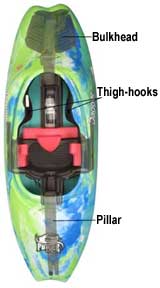 Some boats are outfitted with small adjustable pegs for the feet to push against. Other boats feature adjustable padded plates or cut-and-shape foam blocks known as bulkheads. Pegs are good because they are easily adjustable, allowing the legs to be stretched in slack water.
Some boats are outfitted with small adjustable pegs for the feet to push against. Other boats feature adjustable padded plates or cut-and-shape foam blocks known as bulkheads. Pegs are good because they are easily adjustable, allowing the legs to be stretched in slack water.
Bulkheads
In almost every modern playboat, there is simply no room for an adjustable foot-peg assembly. Bulkheads are good because they provide a stable platform for the entire foot, and thus in the event of a front impact, ankle fractures are minimized. Most manufacturers include pre-shaped foam chunks, allowing boaters to insert as many as necessary to provide a custom fit.
Thigh-hooks
Thigh hooks allow more lower-body movement to transfer to the boat. With the legs inside the boat, a kayaker moves his or her upper body independent from their lower body. The upper body controls the paddle and the boat’s rotation or spin, while the lower body controls the boat’s tilt. The key to boat control is the ability to lift or dip the boat’s edges using hula-dancer-like movements. The knees and lower thighs transmit their movements to the boat via the thigh hooks; the boat then becomes an extension of the lower body. Aggressive hooks reach further down holding more of the kayaker’s legs, resulting in more control. Less aggressive hooks still hold the legs, but are out of the way when the paddler exits the boat.
Pillar
The vertical wall inserted in front and in back of the cockpit, usually made of mini-cell foam. This provides extra structural strength in pinning and broaching situations and prevent the collapse of the boat.
Stability
“Stability” refers to how easily the boat stays right-side-up in the water. Stability is broken down into two broad categories: primary and secondary.
Primary Stability
Primary stability is the relative stability of a boat that is sitting flat on the water right-side-up. A wider base gives increased primary stability. Planing hulls tend to be wider at the water line and thus provide more primary stability. In flat, motionless water, a planing-hulled boat is harder to flip over than a displacement hulled boat.
Secondary Stability
Secondary stability comes into play when the boat is turned on its side. The more surface area touching the water equals better stability. Good secondary stability helps keep the kayak upright when the paddler’s balance goes beyond the primary stability. Generally, no one boat is harder to roll than another. Some boats (like those with good secondary stability) are just easier to roll with bad technique. Technique is the key to good rolls regardless of the boat.
Displacement hulls with soft chines have less primary and more secondary stability.
Planing hulls with hard chines have more primary and less secondary stability.
How to Buy
Once you’ve determined which style of kayaking appeals to you most, it’s time to look for a boat to buy. One of the best options available is the used kayak market. With boat designs evolving so quickly, it’s common to find people who are looking to sell off their current boat so as to buy something brand new. Kayaks that are only a year or two old will often be found for sale at a price much lower than a new boat. From a beginner’s perspective, the difference between a new kayak design and a design from a few years back will be generally unnoticeable. Buying used is a great opportunity to save a few hundred dollars and still get a piece of equipment that will be useful for many years.
The absolute best way to get a feel for a kayak is to paddle one on the water. Clearly, this is not always possible. Failing an on-the-water demo, try to at least sit in the kayak before making a decision. If you are looking at buying a used boat from someone, but can’t get a chance to sit in the actual boat you might buy, see if any local kayakers or kayak clubs or retailers have the same model and will let you sit in theirs. Make sure the boat is appropriate for your body size.
Kayak designs typically have an intended weight range, which indicates who will best fit that boat. Try to put yourself near the middle of a weight range. If you seem to be between sizes, get the boat that is a little too big for you instead of the one that is a little too small. In the beginning, comfort is key. You will learn better if your feet aren’t in pain and your legs aren’t falling asleep. You’ll get enough of that when you buy your first freestyle kayak. For now, find something you feel like you could spend a few hours in without discomfort.
Many manufacturers are making two or three different sizes of the same boat design to accommodate people of all shapes and sizes. Look at the manufacturer’s web page and literature, or ask the kayak guru at your local retailer to help you find the size that is right for you.
Don’t be afraid of getting the “wrong” boat. If you are like most people who are just learning, you’ve got a lot of time on the water ahead of you, and plenty of time to determine what you like and what you don’t. Your first boat is just a vehicle to let you get your feet wet, so to speak. Any whitewater kayak is good if it gets you on the water. As you progress and get more familiar with the differences in boats and what those differences mean in terms of performance, you’ll start getting a feel for what the “right” boat for you is. At that point, you can look into putting your old kayak on the used market and start seeking out the perfect craft to carry you downstream for the next few years.
Kayak Accessories:
Drain Plugs
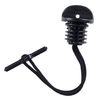 Some boats have these already, some don’t. They can help drain water from the boat, but slowly. Often a sponge is more effective at getting small amounts of water out of the boat. If the boat is flooded, it is quicker to flip it up-side down and let water drain out of the cockpit. NRS sells drain plug assembly kits made by Prijon (for Prijon boats only) and by Pyranha.
Some boats have these already, some don’t. They can help drain water from the boat, but slowly. Often a sponge is more effective at getting small amounts of water out of the boat. If the boat is flooded, it is quicker to flip it up-side down and let water drain out of the cockpit. NRS sells drain plug assembly kits made by Prijon (for Prijon boats only) and by Pyranha.
Float Bags
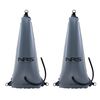 The inflated air-bags made to be inserted into the bow and stern of a kayak. When the boat fills up with water the float bags occupy some of the inner volume. So instead of pulling 45 gallons (360 pounds) of water to shore, your burden is reduced by the volume of the bags. Note: Float bags do not help the boat float in any situation other than when it’s full of water. Keep in mind: Very few planing hull whitewater kayaks will accommodate a bow float bag in front of the paddler’s feet. In most small boats the only flotation necessary is two split stern bags (for boats with pillars) or the one standard stern bag (for Prijon and Eskimo kayaks).
The inflated air-bags made to be inserted into the bow and stern of a kayak. When the boat fills up with water the float bags occupy some of the inner volume. So instead of pulling 45 gallons (360 pounds) of water to shore, your burden is reduced by the volume of the bags. Note: Float bags do not help the boat float in any situation other than when it’s full of water. Keep in mind: Very few planing hull whitewater kayaks will accommodate a bow float bag in front of the paddler’s feet. In most small boats the only flotation necessary is two split stern bags (for boats with pillars) or the one standard stern bag (for Prijon and Eskimo kayaks).
Outfitting and Glue
 Stock boats rarely fit the paddler very well. In order to be in total control of a boat, a tight fit must be achieved. Contoured padding is a must for folks who want optimum performance from their craft. At the very least, hip pads should be added to the sides of the saddle. These transfer power from the body to the boat. A more aggressive play-boater will want to customize his or her entire boat to get a glove-like fit. Most individual Padz are self-adhering. The more comprehensive outfit kits require separate glue. H2Glue works great.
Stock boats rarely fit the paddler very well. In order to be in total control of a boat, a tight fit must be achieved. Contoured padding is a must for folks who want optimum performance from their craft. At the very least, hip pads should be added to the sides of the saddle. These transfer power from the body to the boat. A more aggressive play-boater will want to customize his or her entire boat to get a glove-like fit. Most individual Padz are self-adhering. The more comprehensive outfit kits require separate glue. H2Glue works great.
Ram Caps
 By far the most vulnerable areas of a kayak are the tips. Play-boaters doing cartwheels, squirts and enders in shallow water will shave plastic off the ends of their boats. So will creekers, and just about anyone who hits rocks (intentionally or not). Ram caps can be bolted or glued (depending on the boat) into place and will take a lot of abuse. They can be replaced, keeping the tips looking relatively new.
By far the most vulnerable areas of a kayak are the tips. Play-boaters doing cartwheels, squirts and enders in shallow water will shave plastic off the ends of their boats. So will creekers, and just about anyone who hits rocks (intentionally or not). Ram caps can be bolted or glued (depending on the boat) into place and will take a lot of abuse. They can be replaced, keeping the tips looking relatively new.
Rescue Bag
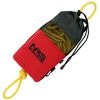 All boaters should carry a rescue bag. They fit in even the smallest rodeo boat and can save a life. For a swimmer rescue, 1/4 inch rope is adequate, but can be difficult to hold on to. 3/8 inch rope is easier to hold, and much stronger.
All boaters should carry a rescue bag. They fit in even the smallest rodeo boat and can save a life. For a swimmer rescue, 1/4 inch rope is adequate, but can be difficult to hold on to. 3/8 inch rope is easier to hold, and much stronger.
Guardian Waist Rescue Bags
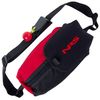 Guardians clip securely around your waist with an adjustable belt and loops for carabineers. The removable throw bag can be easily accessed in an emergency.
Guardians clip securely around your waist with an adjustable belt and loops for carabineers. The removable throw bag can be easily accessed in an emergency.
 NRS Gift Card: Always Fits, Always Wanted
NRS Gift Card: Always Fits, Always Wanted




